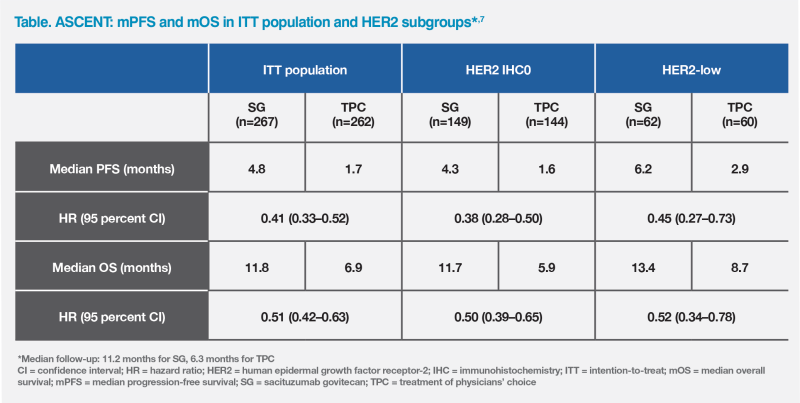Use of a Trop-2–targeted ADC in a heavily pretreated patient with unresectable advanced TNBC





Presentation and initial management
A 43-year-old premenopausal female presented with a left breast mass in April 2022. She had good past health and an excellent performance status. A biopsy showed invasive ductal carcinoma (IDC) that was weakly hormone receptor– positive (oestrogen receptor [ER], 4/8; progesterone receptor [PR], 3/8) and human epidermal growth factor receptor-2–negative (HER2-) with a Ki-67 proliferation index of 60 percent. A PET-CT scan performed at the time of initial diagnosis showed no distant metastases, and the tumour was clinically staged as cT2N0M0. Immediate resection was not feasible as the growth was attached to the underlying muscle.
The patient received six cycles of neoadjuvant chemotherapy with docetaxel, doxorubicin and cyclophosphamide (TAC) between May and October 2022. Afterwards, a left radical mastectomy was performed along with axillary dissection and a transverse rectus abdominis muscle (TRAM) flap breast reconstruction in November 2022. Her post-neoadjuvant tumour stage was T1c(m)N1a and ER/PR/HER2 status had become negative, while Ki-67 index was 15–20 percent. Further re-excision was not recommended by the breast multidisciplinary team (MDT) despite a close surgical margin (<0.1 mm). Adjuvant radiation therapy to the left reconstructed breast and supraclavicular fossa (SCF) was initiated and completed in January 2023. Adjuvant hormone therapy with goserelin and exemestane was started in January 2023 based on initial ER/PR status.
Unfortunately, the patient had early local recurrence in the form of a left breast mass measuring 4.7 x 3.9 x 4.7 cm, which was detected during a bilateral breast ultrasound in March 2023. The tumour was excised in June 2023 and found to be triple-negative with a clinical pathological score (CPS) <1. Patient also underwent germline BRCA testing, which found her to be negative for BRCA1 and BRCA2 mutations. Despite the high risk of recurrence, the patient refused further adjuvant chemotherapy.
Subsequently, multiple recurrent tumours developed on the left chest wall, which led to re-excision in September 2023. The excision specimen tested negative for PD-L1. A postoperative PET-CT scan performed in October 2023 showed residual disease in the left reconstructed breast and metastasis in the left axillary lymph node. Given the multifocal locoregional recurrence, the breast MDT deemed any further excision futile.
The patient then failed to respond to two more lines of chemotherapy given consecutively in November (paclitaxel plus carboplatin) and December (eribulin) 2023, and her cancer remained unresectable.
Treatment with sacituzumab govitecan
Sacituzumab govitecan (SG) treatment was initiated in March 2024. A follow-up PET-CT scan performed in July 2024 revealed a 2.9 cm mass in the anterior chest wall, along with resolution of other left breast and chest wall lesions. In addition, there were no further lesions in the axilla, internal mammary nodes or SCF, nor any distant metastases. The patient received cycle 6 of SG in August 2024, and upon further assessment, the tumour was found to be suitable for excision. She was scheduled to undergo surgery on 5 November 2024.
The last dose of SG was administered on 2 October 2024. The patient had tolerated SG well with anti-diarrhoeal and antiemetic prophylaxis. Her blood cell counts as well as liver and renal function were normal. Her latest KPS scale score was 80. Resuming treatment with SG following surgery had been discussed with the patient, but as the post-operative PET-CT showed no residual disease, patient opted not to continue SG therapy.
Discussion
Our patient had very aggressive IDC, characterized by lack of response to several lines of therapy, which led to multiple surgical resections. In the end, she had very limited treatment options. Fortunately, after receiving SG, there was sufficient response to plan another resection in early November 2024.
SG is a first-in-class antibody-drug conjugate (ADC) targeting trophoblast cell-surface antigen-2 (Trop-2), an epithelial antigen expressed in breast cancer.1,2 It is a guideline-recommended (category I) treatment for patients, such as ours, with unresectable locally advanced or metastatic triple-negative breast cancer (TNBC) who have received at least two previous systemic therapies, including at least one for metastatic disease.3-5
SG demonstrated superior survival benefits over treatment of physicians’ choice (TPC; eribulin, capecitabine, gemcitabine, or vinorelbine) in the phase III, randomized, open-label ASCENT trial in heavily pretreated patients with unresectable locally advanced or metastatic TNBC (n=529).6,7 A post hoc analysis of the ASCENT trial further described SG’s efficacy by HER2 immunohistochemistry (IHC) status (HER2 IHC0 or HER2-low, defined as HER2 IHC1+ or IHC2+ with negative in situ hybridization [ISH-]). Results showed that the survival benefits with SG vs TPC in HER2 IHC0 and HER2-low subgroups were consistent with those in the overall study population, demonstrating that the improvement was independent of HER2 status.7 (Table)

In the ASCENT trial, SG demonstrated a manageable safety profile in patients with metastatic TNBC.8 Our patient tolerated SG very well while receiving prophylactic medications for diarrhoea and vomiting. Active monitoring of blood cell counts along with liver and renal function is important during treatment. In our experience, older patients may require granulocyte-colony stimulating factor support, if they develop neutropoenia while on SG.
Our patient maintained a good performance status after receiving multiple lines of therapy, including SG. In ASCENT, SG was generally associated with greater improvements and delayed worsening of patients’ health-related quality of life (HRQoL) scores compared with TPC.9 The HRQoL assessments covered domains including global health status/QoL, physical functioning, fatigue, and pain.
The present case, along with the efficacy and safety data from the ASCENT trial, support SG as an effective third- or later-line treatment option in patients with metastatic TNBC.